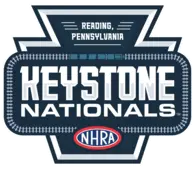

Sticking it to me
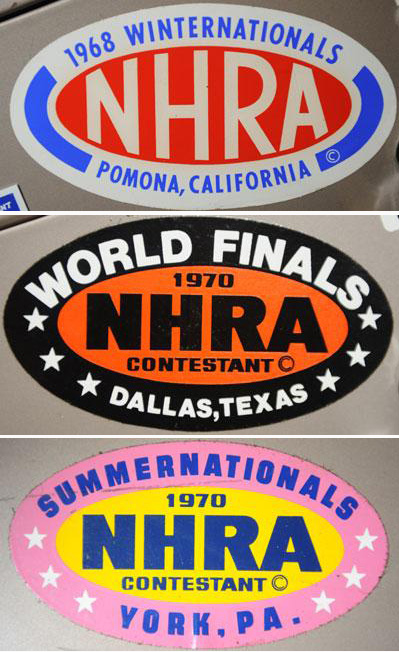 |
I asked for photos of your decals – or "stickers" as many would call them -- so naturally, you guys decided to bury me in submissions. What I present below is just a small but representative sampling of what I received, and I'll start by giving you more than what you expected: a short history of the decal that I unearthed in a quick online search.
The word "decal" is short for decalcomania, which is derived from the French word decalquer ("copy by tracing") and was coined by Simon François Ravenet about 1750. The "mania" suffix was added during the decal craze of the late 19th century, as you will read.
According to another article that I found on the ceramicdecals.org website, Ravenet perfected a way of engraving on copper plates so that underglaze colors could be rubbed onto the heated plates, then tissue paper pressed onto the color, which adhered to the tissue paper, which was then removed and transferred to the item to be decorated. Things went along swimmingly if slowly as better processes were invented, but, according to the article, around 1876, "Somehow, somewhere, someone started decorating with decals as a hobby. Maybe it was because decals had become much easier to use. Maybe it was because the lithograph process could turn out such high quality. Maybe it was because the emerging consumer class couldn't afford hand-decorated china, but they sure could afford to decorate their own. Nobody knows. But we do know this: In 1875, there were only about 300 designs available to decorate with; two years later, there were 10,000!"
The "mania" suffix was thus added, changing the meaning to "decal craze" or "love of decals," and even today, decalcomania is a common word for decals in many countries. Decals were largely a European phenomenon, and the first decals were not imported into the United States until 1860 and not printed in the U.S. until 1894. When silk-screen printing came into its own in the 1930s, it really opened up possibilities and lowered costs, and, well, it was decalcomania times 10, and hot rods haven’t been the same since.
OK, enough of the history lessons; let's see some decals. To accommodate as many as I can, I grouped them, and rather than identify who sent what (especially because they're slightly mixed), I'll thank the following individuals who sent the lion's share: Norman Blake, Tom Derry, Rick Auxier, Dave Wagner, Larry Peters, Dennis Friend, and Mark and Laura Bruederle.
So here we go …
 |
Let's start off with the home team and great old stickers from NHRA events, including these from the 1969 Nationals and World Finals with a wonderful drawing of a Top Fueler with the front tires high and the rear meats blazing ... classic 1960s Top Fuel. NHRA used this same image, reversed, and with slightly different colors, throughout the year.
 |
NHRA also used that same idea the following year with the dragster at left, flipping it back and forth and changing the colors. The middle decal, with the cartoony yet stylish dragster in mid-wheelstand, was one I well remember from early in Winston's sponsorship of the NHRA series. I remember that you could send for these free decals, which I did, one of which still clings to the front of one of my early photo scrapbooks. The event decals later became more square, as evidenced by this one from the 2nd annual Fallnationals in Seattle. I believe they used Ed McCulloch's Revellution Dodge Demon flopper as the model.
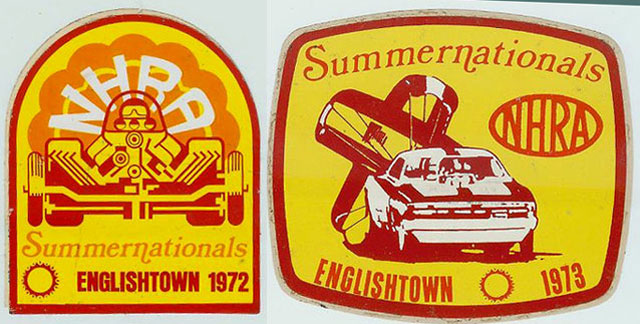 |
Back-to-back years for these Summernationals decals show 1970s influence in the colors and design, especially the 1972 dragster on the left. I also think it's cute how they included the little sun in both the logo and decal because, as anyone who ever went to E-town in the 1970s and 1980s will tell you, the sun played a pretty major factor in the race-going experience.
 |
Yet another Summernationals decal on the left, from 1971, a Funny Car from the 1973 U.S. Nationals (the event name switched from the Nationals to the U.S. Nationals in 1972), and a very interesting and high-concept decal from the 1977 Cajun Nationals, with a driver at the controls of a crawfish, which, like the sun in E-town, if you ever attended the event in those days you know played a huge role in your enjoyment of the event. A fine gentleman who went by the name "Shake" hosted an annual crawfish boil and introduced many a SoCal NHRA official to a first taste of down-home cooking. The 1977 event (labeled here as being in New Orleans instead of Baton Rouge, La., even though The Big Easy is about 75 miles east of Red Stick) was not the first Cajuns; the 1976 event introduced NHRA national event racing to the Pelican State, but it was a non-points-earning exhibition event. The Cajuns also had the distinction (behind Englishtown) of sometimes offering the most inhuman heat/humidity conditions of any stop on the tour.
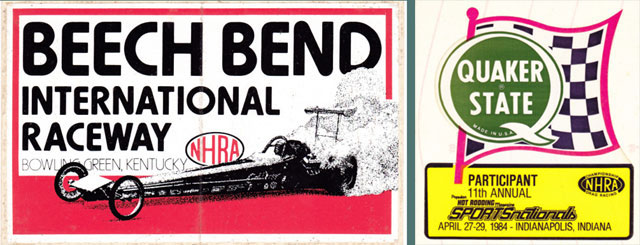 |
And speaking of good times at a national event, none may ever top the experience that racers and fans got at the SPORTSnationals when it was hosted at Beech Bend Raceway Park. The Kentucky facility had its own adjacent amusement park and swimming pools, allowing racers to have some fun between days (and even between runs). The event moved to Indianapolis for two years (1983-84) under the sponsorship of Popular Hot Rodding before returning to Beech Bend in 1985.
 |
Continuing along a PHR thread, the popular SoCal magazine was the longtime sponsor of one of the preeminent match races of the 1970s, the Popular Hot Rodding Championships in Martin, Mich. It was one they all wanted to win and annually drew all of the big names. It also at one time was part of the NHRA points structure as a bonus event that counted for half of a national event, back when there was a limit on the number of points-earning events that racers could attend. The other two decals here, for famous New York National Speedway in Center Moriches, Long Island, represent a less-than-successful venture for the well-appreciated track, the disastrous 1974 PRO race. PRO had just begun to gain traction with successful outings in Tulsa, Okla., in 1972 and 1973, but this one put an end to that. You can find all of the ugly details here in an article titled "P.R.O. is D.O.A. at New York National"; the title alone should tell you a lot.
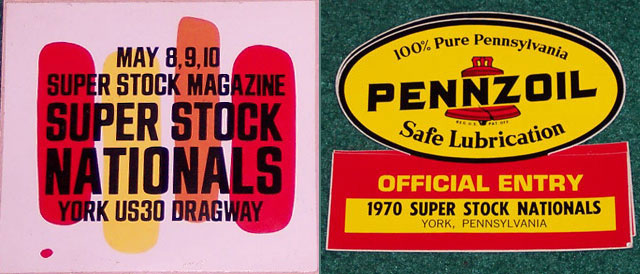 |
As mentioned in my previous decal article, Super Stock magazine hosted a very popular event that, like the PHR race, became a must-attend, especially for the doorslammer crowd. Here are a couple of decals from the 1970s.
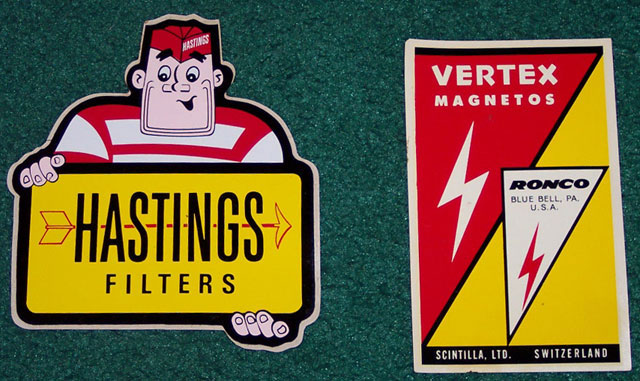 |
You don't have to know much about cars to know that these decals go back a ways just by their design. I love them. Hastings Filters has been in business for more than 60 years selling auto and commercial filters under the slogan "When Performance Matters." I assume that they used to be more heavily involved in motorsports, but I'd never heard of them. Vertex, on the other hand, is a brand name well-known to those who have been around the sport since its earliest days; Vertex magnetos were the hot ticket for many of the sport's fastest cars in the 1950s and 1960s.
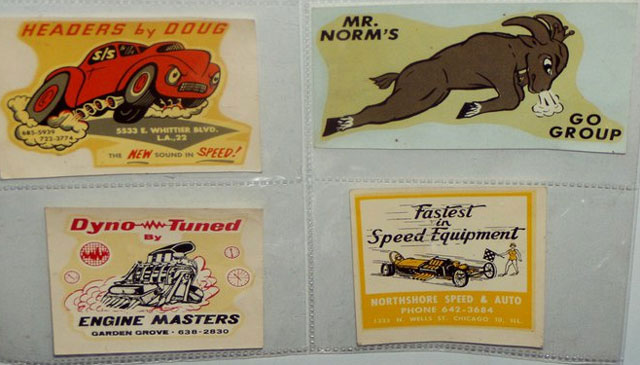 |
Speaking of old decals, here's a neat quartet. Stacked on the left are decals for two great SoCal companies, Headers by Doug and Engine Masters. Headers by Doug, launched by Doug Thorley in 1958 as a small muffler shop in East Los Angeles, later became Doug's Headers and was bannered on all of his Funny Cars. Engine Masters sponsored several Kenny Bernstein-driven, Ray Alley-owned Funny Cars in the early 1970s. The Mr. Norm's sticker with "Go Group" on it is well-remembered for the popular Chicago radio commercial – sung by the rock group The Buckinghams -- urging hot rodders to "get with the Go Group" at Norm Kraus' Grand Spaulding Dodge dealership. Also in Chicago, Northshore Speed & Auto was one of the go-to spots for high-performance goodies in the mid-1960s.
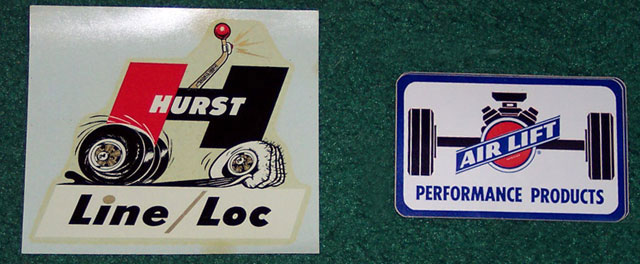 |
You also have to love these retro decals. The one on the left is instantly recognizable as a Hurst shifter decal, this one promoting its innovative Line Loc (though I really have to question whether the hairy knuckles were necessary), and the one on the right promoting the Air Lift company, whose name became famous in drag racing as a sponsor for "Fast Eddie" Schartman and his Air Lift Rattler entries.
 |
Here’s a quartet of decals that should stoke memories. The recognizable Dick Landy Industries decal is a great logo and has a personal attachment because the first car that my parents bought my older sister in 1974 was a beat-up old '64 Dodge that, for some reason, had a DLI sticker on a window. It certainly didn't have any go-fast stuff under the hood. I'm kinda scratching my head over the Center Line Wheels sticker, which not only features a tank, but one emblazoned with the cross of the German army. The next one needs no introduction to veteran race fans because Drag News was the drag racer's Bible before National DRAGSTER even existed (and took away the claim made on this decal: "The only national weekly publication devoted to the sport of drag racing."). Now, sadly, it's just us. And, finally, a sticker for NHRA's Grace Cup, a popular Sportsman program from the middle 1970s until the early 1980s (when Quaker State sponsored it) that rewarded the highest points earner among all of the Sportsman world champs.
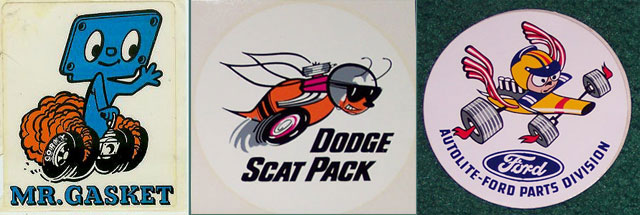 |
Anthropomorphism is a term coined in the mid-1700s to refer to any attribution of human characteristics to animals or nonliving things, and these decals are good examples. I love this early Mr. Gasket decal and the bee in the Dodge Scat Pack sticker. The Scat Pack was Dodge's version of Plymouth's better-publicized (yet subsequently developed) Rapid Transit System (which had a hand in the early Plymouth floppers of Don Prudhomme and Tom McEwen). Officially launched to the public in 1968, the Scat Pack focused on the Charger R/T, Coronet R/T, Dart GTS, Swinger 340, and Super Bee and was featured through print ads, brochures, a national club, decals, and wearables. And finally, there's this what appears to be a hybrid man/race car – looks like an Indy car – for Autolite.
 |
Here are a couple of recognizable animals, the famed tiger from M&H Racemaster slicks – which have been around since the 1950s and still had a huge market share among drag racers until the late 1970s – and Plymouth's Road Runner. To answer your next obvious question, the famous Road Runner cartoon of the high-speed fowl consistently foiling the hunger-driven plans of Wile E. Coyote came first, and Plymouth paid a handsome sum of $50,000 in 1968 to use the name and likeness (and its signature "beep beep," which Plymouth paid $10,000 to develop). The last one is a curious one promoting Deist drag chutes. I'm not really sure what a baby in a carriage has to do with anything, but I sure like the decal.
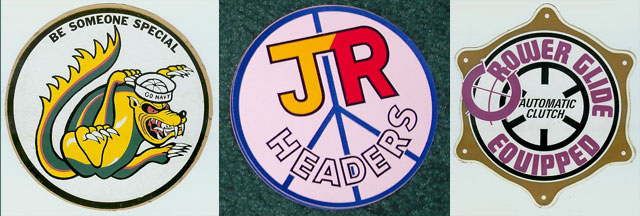 |
Decals didn’t have to be square or rectangular, as this trio proves. The leftmost decal, featuring the famous "Mongoose" of McEwen, is a promotional item for the U.S. Navy, which sponsored McEwen's flopper in the middle 1970s. In the center is a groovy JR Headers logo on a peace-sign background, dating it to the late 1960s or early 1970s. JR was based in Detroit. I really love the clutch-pack-shaped Crowerglide decal. The 'glide was a huge revolution in centrifugal-clutch technology for drag racing that combined the best of several designs into a winning combination that was the industry's first true "slipper" clutch.
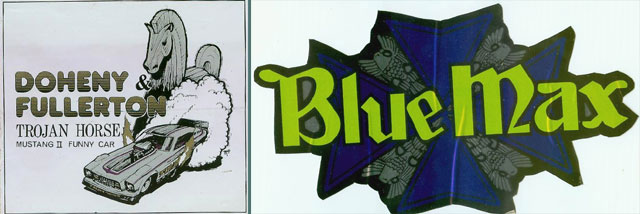 |
Sadly, we've lost the majority of colorful car names that fans rooted for and that promoters screamed over the radio, and here are decals for two memorable ones, Larry Fullerton's Trojan Horse and the Blue Max. Fullerton was a match race expert and only won one NHRA national event, but it was a good one, the 1972 NHRA World Finals in Amarillo, Texas, which made him an NHRA world champ. This decal is from a few years later (1977), of his Mustang II. The Max, first owned by Harry Schmidt and later by his driver, Raymond Beadle, carried this famous logo on its flanks. It's the pour le mérite (“for merit”) emblem, a blue-enameled Maltese cross with eagles between the arms of the cross that was known informally during World War I as “the Blue Max” and was the Kingdom of Prussia’s highest military order until the end of the war.
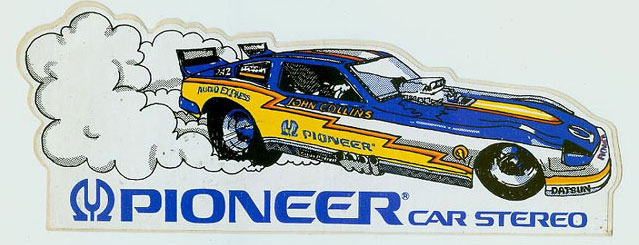 |
I remember falling in love with this car – John Collins' Pioneer Audio Express Datsun 280ZX nitro Funny Car – when it debuted in 1980. After watching an endless parade of Arrows and Monzas and Mustang IIs, when NHRA green-lighted the use of foreign-car bodies in the class beginning in 1980, it was a breath of fresh air, and with its brilliant blue and yellow scheme, it was an eye-catcher, too. I remember him banging it up pretty hard in Bakersfield – I think he blew a tire and ended up in the guardrail – but I loved seeing this car. It just looked fast. Gary Densham had one, too, as did Tim Grose, but theirs both suffered major incidents; Grose's met the guardrail in Columbus, and Densham's burned to the ground at the World Finals at OCIR in 1981. Chuck Etchells, Vern Moats, Fred Mandoline, Bruce Iversen, Larry Dobbs, Larry Reep, John Speelman, Pat Walsh, Billy Williams, and many others famously ran the body – either on nitro or on alcohol – throughout the years.
 |
Here's a colorful decal for my good pal Roland Leong, saluting his Hawaiian Punch Funny Cars that ran for about a decade with drivers Mike Dunn (1983-84), Rick Johnson (1985), Johnny West (1986-88), and Jim White (1989-91). I'd have to guess that this was either the '86 or '87 Daytona that West drove. White made huge history in Leong's ride as the first to exceed 290 mph at the 1991 Dallas event; I recently heard from White and will try to get something from him on this.
The second car shown above is a bit of an oddity. You can read the lettering that this was the Larry Minor-owned, Gary Beck-driven Top Fueler from 1981, and I felt a bit ashamed that I never remembered seeing this car run. I mean, everyone remembers the Minor/Beck car as that big, bad, blue bruiser … but seeing Beck in yellow was like seeing Don Garlits in red. So I did what I always do when I have Beck questions: I turned to his good friend and "personal historian" (and Insider regular) Henry Walther, who came through with the explanation.
"Don't beat yourself up too bad for not remembering that yellow car; you probably never saw it," he reassured me. "That is the car built by Pat Foster and Jim Hume around 1979 for Gary. It was designed to replicate some Funny Car features since the Funny Cars were running quite well in comparison to the dragsters at that time. It also had some F-1 influence in it. Unfortunately, the ideas didn't prove as successful as was hoped.
"As you will remember, Gary went to work for Minor in 1980. Before going to work for him, Gary had a winter tour Down Under at the end of 1979 into January of 1980. As part of the deal with Minor, Gary sold him the Foster-Hume car. When Gary returned from Australia, crew chief Jim Wright had that car and a new Sherm Gunn car ready to go. The Foster-Hume car was painted Pennzoil yellow because Minor was trying to sell Pennzoil on sponsoring the car (they turned him down, though he did get a better product deal). As it turns out, the yellow car was never run in NHRA events. Gary drove the blue Sherm Gunn car instead. The yellow car was used a few times in the sand and then sold before the first Swindahl car arrived at the shop. That car is probably still out there somewhere in the hands of someone who hasn't a clue as to its history."
And so, too, is this column "history." I want to thank everyone who sent decals (please, no more!) and for coming through, as you guys always do, to help share more history and color of this great sport we all love. See you next week.

















